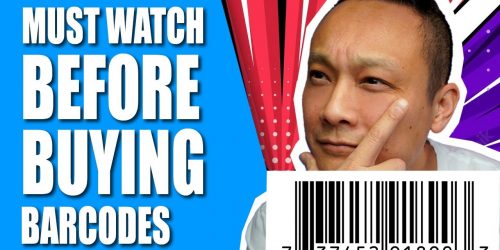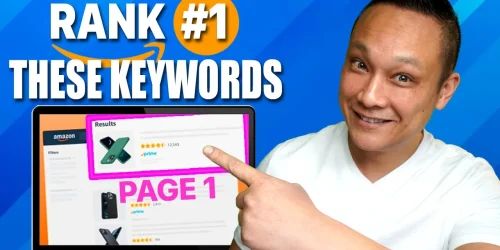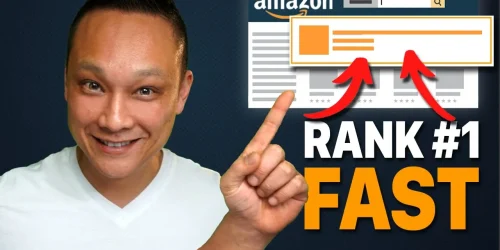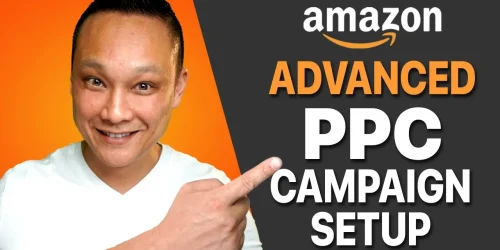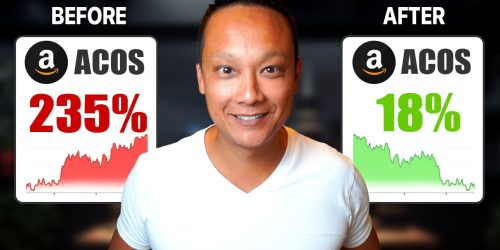How to Set Up Amazon PPC for Sponsored Products Ads Masterclass
Amazon PPC can feel like a money pit—until you structure it correctly. In this masterclass, I’ll walk you through exactly how I set up Sponsored Products campaigns from scratch, using a workflow that’s simple enough for beginners and rigorous enough for pros.
You’ll learn how to:
- Do keyword research the right way (steal converting keywords from top competitors).
- Build clean, strategic keyword lists (main, related, misspellings, and sales-driven).
- Launch six tightly-scoped campaigns that collect clean data you can act on.
- Bid, budget, and place ads to win the top of search more often.
- Read your PPC data like a pro and know what to change and why.
- Use negative keywords to stop wasting money.
Contents
- PPC Fundamentals (Why Your Ads Struggle)
- Keyword Research That Actually Converts
- Build Your Keyword Lists (4 Buckets)
- Match Types (What We Use & Why)
- Campaign Architecture (6 Campaigns That Win)
- Bidding, Budgets & Placement Boosts
- Analyzing & Optimizing (Simple, Repeatable System)
- Negative Keywords (Your Silent Profit Lever)
- FAQ
- Your Launch Checklist
PPC Fundamentals (Why Your Ads Struggle)
- Sponsored Products are the listings with the “Sponsored” label at the top, middle, bottom of result pages, and on product pages. You pay per click.
- Organic ranking is primarily driven by daily sales velocity. Ads help you manufacture visibility and sales to climb organically—especially crucial during launch.
- You can (and should) appear twice: once as a Sponsored placement, and again as an organic result.
Core truth: Amazon ranks by sales, not search volume. If you want to rank faster and cheaper, prioritize high-conversion keywords—not just high-volume keywords.
Keyword Research That Actually Converts
Most sellers copy a list from a tool and dump it into campaigns. That’s why they burn cash.
Here’s the smarter approach:
Step 1: Steal your competitors’ winners (Cerebro)
- Search Amazon for your main product (e.g., “screw-in tent stakes”).
- Grab the ASINs of the top 3 organic competitors (in order).
- Run them through Cerebro (reverse-ASIN).
- Filter:
- Match Type: Organic only
- Competitor Rank (max): ≤ 60 (top page)
- # of Competitors: ≥ 2 (keeps relevance high)
- Remove brands and irrelevant phrases.
- Save to a Master List.
Step 2: Expand smart (Magnet)
- Take your #1 main keyword (highest relevance), run Magnet, and pull an additional 200–300 organic results.
- Again, strip brands, junk, and save only the relevant ones.
Step 3: Harvest misspellings (Misspellinator)
- Export your Master List, paste into Misspellinator, and export non-autocorrected misspellings only.
- Import into a separate Misspelled List (these are cheap converters in Broad).
Step 4: Prioritize
sales-driven
keywords (advanced)
- Build a list centered on high conversion rate and healthy market availability (keywords where sales are distributed beyond the top 3 listings).
- Use filters to keep keywords that:
- Convert ≥ 20%
- Have market availability (sales outside top 3) ≥ 40%
- Show ≥ 25 sales / 30 days
- Are actually your product (verify by searching each term on Amazon)
Why this matters: High-volume keywords often don’t convert. High-conversion phrases drive sales velocity, improve organic ranks faster, and waste less ad spend.
Build Your Keyword Lists (4 Buckets)
You’ll end with four clean, strategic buckets:
| Bucket | What Goes Here | How We’ll Use It |
|---|---|---|
| Main | Hyper-relevant, purchase-intent terms (your exact product) | Exact Match (high bids, high daily budget) |
| Relevant | Closely related terms (buyers might use broader labels) | Exact Match (aggressive but slightly less than Main) |
| Master | All relevant terms (after cleaning) | Broad Match (discovery + cheap sales) |
| Misspelled | Non-autocorrected misspellings | Broad Match (very cheap, often profitable) |
Plus (Advanced): a Sales-Driven list (high conversion & favorable market availability). We’ll run this Broad too for scale and discoverability with quality.
Match Types (What We Use & Why)
- Exact Match: Tight control; best for Main and Relevant lists.
- Broad Match: Captures plurals, order changes, synonyms, and near terms; best for Master, Misspelled, and Sales-Driven.
- Phrase Match: Skipped in this system (Broad already covers it, and we keep analysis clean).
Campaign Architecture (6 Campaigns That Win)
We separate campaigns by intent so the data stays clean and optimization is trivial.
Campaign Setup Summary
| # | Campaign Name (example) | Targeting | Match | Keyword Source | Daily Budget* | Bid Strategy |
|---|---|---|---|---|---|---|
| 1 | Tent Stake – Main – Exact | Manual | Exact | Main list | $100 | Dynamic Up & Down |
| 2 | Tent Stake – Relevant – Exact | Manual | Exact | Relevant list | $100 | Dynamic Up & Down |
| 3 | Tent Stake – Master – Broad | Manual | Broad | Master list | $20 | Dynamic Up & Down |
| 4 | Tent Stake – Misspelled – Broad | Manual | Broad | Misspelled list | $10 | Dynamic Up & Down |
| 5 | Tent Stake – Sales Volume – Broad | Manual | Broad | Sales-driven list | $100 | Dynamic Up & Down |
| 6 | Tent Stake – Suggested – Broad | Manual (Suggested) | Broad | Amazon suggested | $10 | Dynamic Up & Down |
| 7 | Tent Stake – Auto | Automatic | — | Amazon auto | $10 | Dynamic Up & Down |
* Why big budgets on Exact and Sales-Driven? We want max impressions and data velocity. You still only pay on clicks. Manually pause for the day when you hit your true daily spend.
Bidding Rules (launch week)
- Aggressive bids: Outbid suggested by ~$1 (or ~25% if you want to be less aggressive).
- Use odd cents (e.g., $1.13, $1.27) to win tiny auctions cheaply.
- Dynamic Up & Down during launch. Consider “Down Only” later if you need to control costs.
Bidding, Budgets & Placement Boosts
Placement Strategy
Check Placements at the campaign level:
- Top of Search (First Page) – usually highest intent. If profitable (ACOS < margin), increase placement by +10% (incrementally).
- Rest of Search / Product Pages – if ACOS is high, don’t boost.
Hack to reduce poor placements:
If you boosted Top of Search by +10%, lower all keyword bids by 10% in that campaign. Net effect:
- Top of Search stays effectively the same (because of the +10% boost).
- Everywhere else gets 10% cheaper, reducing ACOS outside Top placements.
Analyzing & Optimizing (Simple, Repeatable System)
Let each campaign run 7–10 days before making changes. Week-to-week, follow this exact flow:
1) Read the Four Core Metrics
| Metric | Meaning | If It’s Low / High | What To Check / Do |
|---|---|---|---|
| Impressions | Times your ad was shown | Low | Bids too low, poor relevance, budget exhausted early |
| CTR | Clicks ÷ Impressions | Low | Title/image/reviews weak, targeting off; improve main image & title clarity |
| Conversion Rate | Orders ÷ Clicks | Low | Listing quality, price, reviews, irrelevant traffic |
| ACOS | Ad Spend ÷ Ad Sales | High | Overbidding, weak conversion, wrong keywords/placements |
Know your break-even ACOS (= Profit margin %). Anything above that loses money.
2) Process Each Campaign Report (Excel/Numbers)
- Sort by ACOS (desc):
- Red (Kill): ACOS ≫ break-even → Turn off those keywords (or move to negatives if not already in your list).
- Yellow (Watch): Slightly above break-even or borderline spend/clicks → Reduce bid in $0.10 steps, re-check next cycle.
- Green (Scale): Profitable terms → Move into a “Good Keywords – Exact” campaign (same match type); raise daily budget.
- Sort remaining by Spend (desc):
- No sales but spend ≥ ~3× profit per unit → Red (Kill/Neg).
- No sales with low spend/clicks → leave running (not enough data).
Rhythm: Optimize weekly, not daily. PPC data is noisy; let Thursday–Monday demand play out.
Negative Keywords (Your Silent Profit Lever)
Use negatives to prevent matching on irrelevant searches (especially in Broad and Auto).
- Where: Add negatives at the Ad Group or Campaign level.
- What to negate:
- Irrelevant product types you don’t sell (e.g., “glow in the dark” if you’re not selling it).
- Brand names you’re not targeting.
- Consistently high-spend, zero-sale search terms from reports.
- Match type for negatives:
- Exact Negative for a single phrase.
- Phrase Negative to block the phrase plus variants.
Example: Budgeting & Bid Strategy Snapshot
| Campaign | List | Match | Launch Daily Budget | Bid Style | Notes |
|---|---|---|---|---|---|
| Main | Main | Exact | $100 | Aggressive (+$1 over suggested) | Highest intent → fastest ranking lift |
| Relevant | Relevant | Exact | $100 | Aggressive | Slightly broader, still strong |
| Master | Master | Broad | $20 | Moderate | Discovery with control |
| Misspelled | Misspelled | Broad | $10 | Low-moderate | Cheap conversions |
| Sales-Driven | Sales-Driven | Broad | $100 | Aggressive | High-conversion focus |
| Suggested | Amazon Suggested | Broad | $10 | Moderate | Catch stragglers |
| Auto | Amazon Auto | — | $10 | Moderate | Let Amazon find edges |
FAQ
When should I start PPC?
Immediately when your listing goes live. Don’t waste the honeymoon period waiting on images or copy.
Exact vs Broad—why both?
- Exact: cleanest intent → best data, tight control.
- Broad: finds cheap wins, variants, and angles you didn’t consider.
How long before I judge a keyword?
Let it get enough data. A simple rule: don’t kill unless spend ≥ ~3× profit with no sales or ACOS is well above break-even for a week.
Top of Search seems expensive—worth it?
If ACOS is under margin, yes. That spot converts better and accelerates organic ranking. Use the placement hack to reduce wasted spend elsewhere.
Your Launch Checklist
- Listing ready (killer main image, clear title, benefits-driven bullets, competitive price, early reviews plan).
- Keyword lists built: Main, Relevant, Master, Misspelled (+ Sales-Driven).
- Six campaigns + Auto created with proper match types and naming.
- Aggressive initial bids (launch week), Dynamic Up & Down selected.
- Daily budgets set high on Exact & Sales-Driven (pause manually at your true cap).
- Placement review after first week; use +10% Top of Search and the bid-down hack.
- Weekly optimization cadence (Red/Yellow/Green system).
- Negatives updated from search term data.

